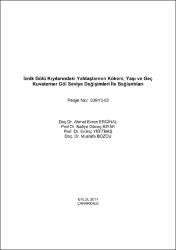| dc.contributor.author | Erginal, Ahmet Evren | en_US |
| dc.contributor.author | Bozcu, Mustafa | en_US |
| dc.contributor.author | Güneç Kıyak, Nafiye | en_US |
| dc.contributor.author | Yiğitbaş, Erdinç | en_US |
| dc.date.accessioned | 2020-09-15T08:58:46Z | |
| dc.date.available | 2020-09-15T08:58:46Z | |
| dc.date.issued | 2011-09 | |
| dc.identifier.citation | Erginal, A. E., Bozcu, M. & Güneç Kıyak, N. (2011). İznik Gölü kıyılarındaki yalıtaşlarının kökeni, yaşı ve geç kuvaterner göl seviye değişimleri ile bağlantıları. Tübitak, 1-135. | en_US |
| dc.identifier.uri | https://hdl.handle.net/11729/2379 | |
| dc.identifier.uri | https://app.trdizin.gov.tr/proje/TVRFMk1qZzQ | |
| dc.description.abstract | İznik Gölü kıyılarında yalıtaşı oluşumunun kökeni, yaşı ve göl su seviyesi değişimleri ile bağlantılarının ele alındığı bu projede göl kıyısında 10 farklı lokalitede saptanan yalıtaşlarının jeomorfolojik, mineralojik-petrografik ve mikroanalitik incelemeleri ile optik lüminesans tarihlendirmeleri yapılarak böylesi bir tatlı su ortamında yalıtaşı oluşumunun gerekçeleri sorgulanmıştır. 53 yalıtaşı örneği üzerinden yapılan analiz ve tarihlendirme sonuçlarına göre birçok lokalitede polijenik konglomera seviyeleri ile başlayan yalıtaşlarında en eski yaş 20.285±2.067, en genç yaş ise 0.706±0.081 yıldır. Yalıtaşı oluşumunun 2 farklı dönemde yoğunluk kazandığı görülmektedir; son buzul maksimumu-Holosen arasındaki soğuk kurak devre, Klimatik Optimum ve Geç Holosen‟deki sıcak kurak devre. Taban birimini oluşturan konglomeratik düzeyler son buzul çağında göl seviyesinin alçalmamış olduğunu, aksine yüksek enerjili koşullarda bugünküne yakın bir seviyede plaj materyallerinin çimentolandığını göstermektedir. Klimatik optimum ve Geç Holosen‟de gelişen yalıtaşları ise göl seviyesinin bugüne göre 2 metre kadar alçaldığı devrede artan kuraklık ve buharlaşma sayesinde hızlanan aragonit çökelimi sonucunda gelişmiş olup, eski yalıtaşı düzeyleri üzerine süperimpoze olarak çimentolanmış olmalıdır. Yalıtaşlarının çimento mikromorfolojileri mikritik zarflar, boşluk dolguları, aragonit rimler, iğne yapıları ve menisküs çimento formları gibi denizel ortamda gel-git içi zonu karakterize eden yalıtaşları ile benzer çimento yapılarına sahiptir. Hemen tüm örneklerde düşük tuzlulukta deniz suyuna benzer bileşim veren 13C ve 18O bileşimleri ile de doğrulandığı gibi, bu durum göl suyunun jeokimyasal özellikleri, yüksek pH koşulları ve iklim koşullarının aragonit çökelimine uygun şartlar yarattığını göstermektedir. Kuzey Anadolu Fayı‟na dayalı deprem aktivitesinin, bir lokalitedeki sınırlı örnek dışında, yalıtaşlarına etkisi gözlenmemiştir. | en_US |
| dc.description.abstract | In this project which aims the origin and age of beachrocks and their relationships with changes of water level of the Iznik Lake, we investigated the mechanism of beachrock formation in a such fresh-water environment based on geomorphological, mineralogicpetrographic and microanalytical data and optical luminescence ages of beachrocks determined at ten different sections of the lake shoreline. The analysis and dating results from 53 samples of beachrocks which start with polygenic conglomerate at the bottom reveal that the oldest and youngest ages are 20.285±2.067 ka and 0.706±0.081 ka, respectively. Beachrock cementation appears to have occurred mostly at two different periods; i.e.a cold and dry period between the Last Glacial Maximum and Holocene and a hot and dry period between Climatic Maximum and the Late Holocene. The basal conglomeratic units may explain that the level of the lake during the last glacial was not descended, but, contrary to this, was at a similar position when beach materials were deposited under high energy conditions. The younger beachrocks which formed during climatic optimum and Late Holocene might have superimposed on older cemented beds as the result of precipitation of connective aragonite due to increased drought and evaporation when lake level was 2 m lower than the present one. The cement micro-morphologies of beachrocks comprise micritic envelops, pore-fillings, aragonite rims and meniscus bridges, as similar to those in intertidal beachrocks of sea coasts. As confirmed by 13C and 18O values which yielded similar compositions to that of eurohaline marine waters, this explains that geochemical composition, high pH and climatic features create favorable conditions for the precipitation of aragonite. With the exception of one example, no effect of earthquake by the North Anatolian Fault to beachrocks was determined. | en_US |
| dc.description.sponsorship | TÜBİTAK | en_US |
| dc.language.iso | tur | en_US |
| dc.publisher | Tübitak | en_US |
| dc.rights | info:eu-repo/semantics/openAccess | en_US |
| dc.rights | Attribution-NonCommercial-NoDerivs 3.0 United States | * |
| dc.rights.uri | http://creativecommons.org/licenses/by-nc-nd/3.0/us/ | * |
| dc.subject | Yalıtaşı | en_US |
| dc.subject | Yalıtaşı çimentolanması | en_US |
| dc.subject | Mutlak yaşlandırma | en_US |
| dc.subject | Jeokronoloji | en_US |
| dc.subject | Tatlı su ortamı | en_US |
| dc.subject | İznik Gölü | en_US |
| dc.subject | Beachrock | en_US |
| dc.subject | Beachrock cementation | en_US |
| dc.subject | Absolute dating | en_US |
| dc.subject | Geochronology | en_US |
| dc.subject | Freshwater lake environment | en_US |
| dc.subject | Lake Iznik | en_US |
| dc.title | İznik Gölü kıyılarındaki yalıtaşlarının kökeni, yaşı ve geç kuvaterner göl seviye değişimleri ile bağlantıları | en_US |
| dc.type | project | en_US |
| dc.contributor.department | Işık Üniversitesi, Fen Edebiyat Fakültesi, Fizik Bölümü | en_US |
| dc.contributor.department | Işık University, Faculty of Arts and Sciences, Department of Physics | en_US |
| dc.identifier.startpage | 1 | |
| dc.identifier.endpage | 135 | |
| dc.peerreviewed | Yes | en_US |
| dc.publicationstatus | Published | en_US |
| dc.relation.tubitak | info:eu-repo/grantAgreement/TUBITAK/ÇAYDAG/109Y143 | |
| dc.relation.publicationcategory | Diğer | en_US |
| dc.contributor.institutionauthor | Güneç Kıyak, Nafiye | en_US |




















